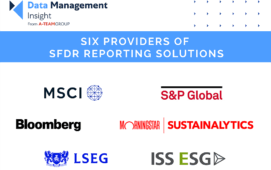As the world of reference data moves to a phase of relative maturity, the landscape is becoming littered with the usual ‘after-dinner circuit’ of case studies, interviews and Powerpoints gloating about how the data challenge has finally been met. Instead of the chaos we uncovered three years ago – has it been that long? – when we launched Reference Data Review, the reference data steer has been broken, and the industry’s talk is of governance, best practices and ROI.
So far, so good. Progress, it seems, has been made. It’s just the simple matter of implementing, right?
Wandering around the SIA Show this month, we enjoyed two very interesting conversations with a couple of people, the existence of whose businesses suggests that the data management world isn’t quite as rosy as many of the industry’s thought leaders might have you believe.
Tom Jordan, who’s fronted Jordan & Jordan since leaving Knight-Ridder Financial back in 1989 or 1990, has started to gain traction helping firms implement their reference data management projects, just as he did with market data implementations all through the ‘90s. J&J has had some success in formulating a reference data consulting practice, and has even developed a set of processes and tools to help it and its clients test internal reference data management capabilities.
And then there’s Steve Semenzato, CEO of ClusterSeven, which is in the process of evangelizing the strategic nature of the lowly spreadsheet.
Why should we care?
Semenzato says we should care because the spreadsheet – or rather the messy, unstructured data that resides within the spreadsheet – just might be the next frontier in winning the data management West.
Semenzato argues that financial institutions need to recognize that spreadsheets have become a strategic element of their systems infrastructure. Part of the reason for this is that spreadsheets represent a powerful tool that sits outside of the IT empire. They allow business people – traders, analysts, investment bankers – to formulate their own models, outside of the controlled realm of a bank’s ‘strategic’ systems and platforms.
Of course, regulators have waded in and decreed auditability of spreadsheets used in various operational areas. Firms’ responses to these regulatory requirements, though, are in effect negative; they audit and control spreadsheets in order to comply.
Semenzato argues that if firms were to concede that spreadsheets were in fact strategic assets, then they could benefit from a more positive or proactive approach to managing them. This is where ClusterSeven comes in. The company’s software provides a continuous audit of changes to spreadsheets’ structure, data and formulas. Semenzato’s line is that this can help firms bring spreadsheets into the strategic technology environment – and rein in the mass of unstructured data that currently sits on many a financial markets professional’s desktop PC.
ClusterSeven isn’t the only company to twig to the value of spreadsheet-based data. Data platform provider Xenomorph has just added a ‘Spreadsheet Inside’ capability to its TimeScape system. Perhaps the unstructured world of .xls is about to be welcomed into the data management fold.
Subscribe to our newsletter




